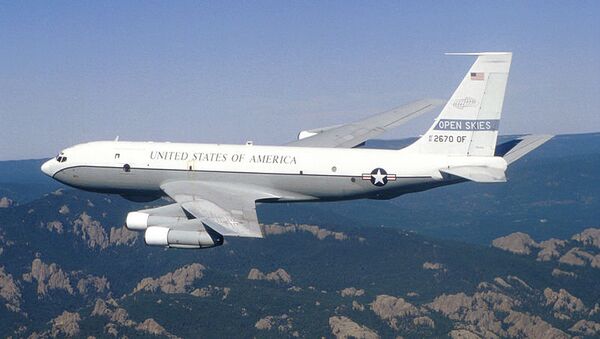Earlier this year, one of the US Air Force’s Open Skies planes was removed from service after receiving camera upgrades. The 1993 Treaty on Open Skies has specific requirements for planes making flights under the treaty, and the replacement of a wet-film camera with a digital camera required Moscow’s approval first. As a consequence, the US had just one usable OC-135B, which still had wet film that needed replacing.
Then in late May, US President Donald Trump announced the United States’ formal withdrawal from the treaty, claiming Russia was noncompliant for barring certain flights over certain places at certain times, even though this is allowed by the treaty. As a consequence, the Air Force has now officially withdrawn its solicitation notice seeking bids from defense firms willing to do the upgrade work.
“On 22 May 2020, the United States provided formal notice of its intent to withdraw from the Treaty on Open Skies. As a result, this announcement is hereby cancelled,” reads the curt notice posted by the Air Force on the beta.sam.gov contract site on July 14.
The writing about Open Skies was on the wall before Trump’s announcement, though: in March, Defense Secretary Mark Esper told the Senate Armed Services Committee that efforts for Open Skies aircraft were on hold until Washington’s plan with regards to the treaty became clearer.
“At this point and time, until we make a final decision on the path forward, I’m not prepared to recapitalize aircraft,” Esper said. “We’re holding until we get better direction.”
The treaty permits 35 countries to conduct overflights in other countries in the interest of defusing tensions by dispelling suspicions the other side is secretly preparing an attack. In practice, however, most of the signatories are US allies and use the treaty to fly over parts of Russia and Belarus; only Russia has shown significant interest in overflights across the US. As a consequence, the foreign ministries of nearly a dozen European countries issued a joint statement in May stating the treaty remained "functional and useful."
Talks on saving the treaty from the scrapheap were due to begin this week. US Secretary of State Mike Pompeo has said the US would “reconsider our withdrawal should Russia return to full compliance with the Treaty.” However, Moscow has firmly denied any noncompliance, leaving it unlikely the two parties will reach an accommodation for reviving the treaty.
‘The Real Reasons Are Not Those Declared’
On Thursday, Sergei Ryzhkov, the head of the Russian Defense Ministry's National Center for Reducing Nuclear Danger, told the Russian military paper Krasnaya Zvezda the US’ accusations were simply “a pretext” for its intention to withdraw.
“The real reasons for the US withdrawal from the [Open Skies Treaty] are not those declared by the Americans,” Ryzhkov said. “First: the desire of the Americans to control all of space (communication systems, navigation, space debris control, remote sensing of the Earth, etc.), and make good money on this in the future by selling relevant materials. Second: to no longer allow the inspection of US territory.”
On Wednesday, a Minotaur IV rocket blasted off from NASA’s Wallops Flight Facility in eastern Virginia carrying the US Space Force’s (USSF’s) first mission. According to the Salisbury Daily Times, the rocket carried four classified payloads for the National Reconnaissance Office. NRO Director Chris Scolese told the paper the agency’s burgeoning satellite network "will demonstrate revolutionary capabilities of value to the nation and our allies,"
"Despite facing challenges in 2020, we found new and better ways to collaborate with our partners from a distance, relentlessly pursuing our mission and denying sanctuary to our adversaries," Scolese said.
The US Air Force also recently announced the selection of 2,410 service members who will begin transfer to the USSF by February 2021.



